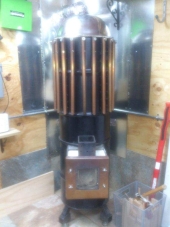




 1
1




Success has a Thousand Fathers , Failure is an Orphan
LOOK AT THE " SIMILAR THREADS " BELOW !




 This is helping us to make decisions and to move on with the project. Will go for cheapest material for pipe runs then, and get better materials for the T's and the bits that go outside through the wall. Have looked at the video on burning the barrel and pipes too. We are thinking about using 8 inch t junctions, and then using standard size (5 inch) plug holes and caps (that you can buy here cheaply) by fitting them in a short length of 5 inch pipe (the standard here), and cobbing that short piece of 5 inch into the 8 inch T junction pipe, to plug the hole. I assume that won't be a problem for the air flow since that is just a small section to the cleanout and the "main run"of the pipes is uninterrupted 8 inch pipe? We think this is a good idea because it will be difficult to get good airtight plug caps made for us especially in the right diameter of the whole system.
This is helping us to make decisions and to move on with the project. Will go for cheapest material for pipe runs then, and get better materials for the T's and the bits that go outside through the wall. Have looked at the video on burning the barrel and pipes too. We are thinking about using 8 inch t junctions, and then using standard size (5 inch) plug holes and caps (that you can buy here cheaply) by fitting them in a short length of 5 inch pipe (the standard here), and cobbing that short piece of 5 inch into the 8 inch T junction pipe, to plug the hole. I assume that won't be a problem for the air flow since that is just a small section to the cleanout and the "main run"of the pipes is uninterrupted 8 inch pipe? We think this is a good idea because it will be difficult to get good airtight plug caps made for us especially in the right diameter of the whole system.







 1
1




Success has a Thousand Fathers , Failure is an Orphan
LOOK AT THE " SIMILAR THREADS " BELOW !








 They are almost double the price if they order the amount we need now so to reduce costs we are going to make the heat riser from steel shape and perlite / clayslip mixture instead of firebricks as initially was the plan. The guys in the shop are trying to persuade us to add a bit of fire cement to the mix of perlite, so that if the steel burns away the perlite will hold shape better? would that be a good idea? I am hoping to post photos of our progress so that it will be useful for others to see how we get on....
They are almost double the price if they order the amount we need now so to reduce costs we are going to make the heat riser from steel shape and perlite / clayslip mixture instead of firebricks as initially was the plan. The guys in the shop are trying to persuade us to add a bit of fire cement to the mix of perlite, so that if the steel burns away the perlite will hold shape better? would that be a good idea? I am hoping to post photos of our progress so that it will be useful for others to see how we get on.... 










Success has a Thousand Fathers , Failure is an Orphan
LOOK AT THE " SIMILAR THREADS " BELOW !










Success has a Thousand Fathers , Failure is an Orphan
LOOK AT THE " SIMILAR THREADS " BELOW !


















Success has a Thousand Fathers , Failure is an Orphan
LOOK AT THE " SIMILAR THREADS " BELOW !




 hope you are well!
hope you are well!










|
Bananas grow on a stalk like grain. And in bunches like grain. This tiny ad says "grain"
The new purple deck of permaculture playing cards
https://www.kickstarter.com/projects/paulwheaton/garden-cards
|






